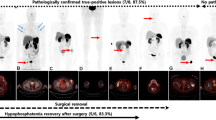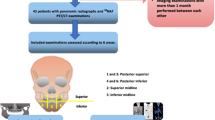Abstract
Osteonecrosis of the maxillary or mandibular bone is an infrequent but often severe event occurring in patients who undergo prolonged treatment with bisphosphonates. Histology is in some cases mandatory to differentiate it from neoplastic osteolysis, but a biopsy can further contribute to bone damage. Functional imaging obtained by a tracer that shows oncotropic properties, such as Tc99m-sestamibi, in comparison to a non-tumor-specific substance such as FDG-PET, can support the differential diagnosis, thus avoiding invasive procedures. Four patients affected by multiple myeloma and jaw osteonecrosis were prospectively evaluated by sestamibi and FDG-PET scans. Local diagnosis was performed by clinical, radiological and, in some cases, histological evaluations. Each patient was studied by Tc99m-sestamibi, performed by planar anterior and posterior whole-body scans and SPECT of the head and neck, and by PET/CT. Two nuclear medicine physicians, unaware of the final diagnosis, reviewed the images. No sestamibi uptake was evident in the four patients with jaw osteonecrosis, while FDG-PET/CT showed focal uptake in all of them. Our study suggests that the combined use of sestamibi scintigraphy and FDG-PET/CT could support the clinical diagnosis of oral osteonecrosis avoiding the risks of a surgical biopsy. Studies on higher number of patients are necessary to validate these preliminary observations.







Similar content being viewed by others
References
Ruggiero SL, Mehrotra B, Rosenberg TJ, Engroff SL (2004) Osteonecrosis of the jaws associated with the use of bisphosphonates: a review of 63 cases. J Oral Maxillofac Surg 62:527–534
Marx RE (2003) Pamidronate (Aredia) and Zoledronate (Zometa) induced avascular necrosis of the jaws: a growing epidemic. J Oral Maxillofac Surg 61:1115–1118
Ruggiero S, Gralow J, Marx RE, Hoff AO, Schubert MM, Huryn JM, Toth B, Damato K, Valero V (2006) Practical guidelines for the prevention, diagnosis and treatment of osteonecrosis of the jaw in patients with cancer. J Oncol Pract 2:7–14
Fleisch H (1998) Bisphosphonate: mechanisms of action. Endocr Rev 19:80–100
Ashcroft AJ, Davies FE, Morgan GJ (2003) Aetiology of bone disease and the role of bisphosphonates in multiple myeloma. Lancet Oncol 4:284–292
Berenson JR, Lichtenstein A, Porter L, Dimopoulos MA, Bordoni R, George S, Lipton A, Keller A, Ballester O, Kovacs MJ, Blacklock HA, Bell R, Simeone J, Reitsma DJ, Heffernan M, Seaman J, Knight RD (1996) Efficacy of pamidronate in reducing skeletal events in patients with advanced multiple myeloma. N Engl J Med 334:488–493
Berenson JR, Lichtenstein A, Porter L, Dimopoulos MA, Bordoni R, George S, Lipton A, Keller A, Ballester O, Kovacs MJ, Blacklock HA, Bell R, Simeone J, Reitsma DJ, Heffernan M, Seaman J, Knight RD (1998) Long-term pamidronate treatment of advanced multiple myeloma patients reduces skeletal events. J Clin Oncol 16:593–602
Bamias A, Kastritis E, Bamia C, Moulopoulos LA, Melakopoulos I, Bozas G, Koutsoukou V, Gika D, Anagnostopoulos A, Papadimitriou C, Terpos E, Dimopoulos MA (2005) Osteonecrosis of the jaw in cancer after treatment with bisphosphonates: incidence and risk factors. J Clin Oncol 23:8580–8587
Durie BGM, Katz M, Crowley J (2005) Osteonecrosis of the jaw and bisphosphonates. N Engl J Med 353:99–102
Catalano L, Caparrotti G, Martorelli MC, Califano C, Esposito D, Cicoira L, Graziani F, De Falco G, Mignogna F, De Santis R, Castaldo C, Petruzziello F, D’Arco A, Pagnini D, Rotoli B (2006) Bisphosphonates and risk of osteonecrosis of the jaw. Haema 9:410–414
Ciu ML, Kronauge JF, Piwnica-Worms D (1990) Effects of mitochondrial and plasma membrane potentials on accumulation of hexakis(2-methoxyisobutyl isonitrile) technetium in cultured mouse fibroblast. J Nucl Med 31:1646–1653
Kostkiewicz M, Tracz W, Przewlocki T, Kawalec E (2001) Predictive potential of noninvasive methods, inclusive of exercise SPECT Tc99m MIBI imaging, in recognition of high-risk patients with left main coronary artery stenosis. Int J Cardiovasc Imaging 17:347–352
Hassan IM, Sahweil A, Costantinides C, Mahmound A, Nair M, Omar YT, Abdel-Dayem HM (1989) Uptake and kinetics of tc-99m hexakis 2-methoxyisobutyl isonitrile in benign and malignant lesions in the lungs. Clin Nucl Med 14:333–340
Caner B, Kitapci M, Aras T, Erbengi G, Ugur O, Bekdik C (1991) Increased accumulation of 2-methoxyisobutylisonitrile technetium in osteosarcoma and its metastatic lymph nodes. J Nucl Med 32:1977–1978
Kitapci MT, Tastekin G, Turgut M, Caner B, Kars A, Barista I, Bekdik C (1993) Preoperative localization of parathyroid carcinoma using 99mTc-MIBI. Clin Nucl Med 18:217–219
Kao CH, Wang SJ, Liu TJ (1994) The use of technetium-99m-methoxyisobutyl isonitrile breast scintigraphy to evaluate palpable breast masses. Eur J Nucl Med 21:432–436
Wakasugi S, Teshima H, Nakamura H, Hashizume T, Maeda T, Hiraoka A, Hasegawa Y, Masaoka T (1998) Tc-99m MIBI localization in bone marrow: a marker of bone marrow malignancy. Clin Nucl Med 23:664–671
Tirovola EB, Biassoni L, Britton KE, Kaleva N, Kouykin V, Malpas JS (1996) The use of Tc-99m MIBI scanning in multiple myeloma. Br J Cancer 74: 1815–1820
Adams BK, Fataar A, Nizami MA (1996) Technetium-99m-sestaMIBI uptake in myeloma. J Nucl Med 37:1001–1002
Pace L, Catalano L, Del Vecchio S, Di Gennaro F, De Renzo A, Sica G, Califano C, Tedesco N, Borrelli G, Rotoli B, Salvatore M (2001) Predictive value of technetium-99m sestamibi in patients with multiple myeloma and potential role in the follow up. Eur J Nucl Med 28:304–312
Balleari E, Villa G, Garre S, Ghirlanda P, Agnese G, Carletto M, Clavio M, Ferrando F, Gobbi M, Mariani G, Ghio R (2001) Technetium-99m-sestamibi scintigraphy in multiple myeloma and related gammopathies: a useful tool for the identification and follow-up of myeloma bone disease. Haematologica 86:78–84
Svaldi M, Tappa C, Gebert U, Bettini D, Fabris P, Franzelin F, Osele L, Mitterer M (2001) Technetium-99m-sestamibi scintigraphy: an alternative approach for diagnosis and follow up of active myeloma lesions after high-dose chemotherapy and autologous stem cell transplantation. Ann Hematol 80:393–397
Fonti R, Del Vecchio S, Zanetti A, De Renzo A, Di Gennaro F, Catalano L, Califano C, Pace L, Rotoli B, Salvatore M (2001) Bone marrow uptake of 99m Tc-MIBI in patients with multiple myeloma. Eur J Nucl Med 28:214–220
Catalano L, Pace L, Califano C, Pinto AM, De Renzo A, Di Gennaro F, Del Vecchio S, Fonti R, Salvatore M, Rotoli B (1999) Detection of focal myeloma lesions by technetium-99m-sestaMIBI scintigraphy. Haematologica 84:119–124
Jadvar H, Conti PS (2002) Diagnostic utility of FDG-PET in multiple myeloma. Skeletal Radiol 31:690–694
Schirrmeister H, Bommer M, Buck AK, Muller S, Messer P, Bunjes D et al (2002) Initial results in the assessment of multiple myeloma using FDG-PET. Eur J Nucl Med 29:361–366
Durie GM, Waxman AD, D’Agnolo A, Williams CM (2002) Whole body 18F-FDG-PET identifies high-risk myeloma. J Nucl Med 43:1457–1463
Nanni C, Zamagni E, Farsad M, Castellucci P, Tosi P, Cangini D, Salizzzoni E, Canini R, Cavo M, Fanti S (2006) Role of 18F-FDG PET/CT in the assessment of bone involvement in newly diagnosed multiple myeloma: preliminary results. Eur J Nucl Med Mol Imaging 33: 525–531
Mileshkin L, Blum R, Seymour JF, Patrikeos A, Hicks RJ, Prince HM (2004) A comparison of fluorine-18 fluorodeoxyglucose PET and technetium-99m sestamibi in assessing patients with multiple myeloma. Eur J Haematol 72:32–37
Shreve PD (1998) Focal fluorine-18 fluorodeoxyglucose accumulation in inflammatory pancreatic disease. Eur J Nucl Med 25:259–264
Yamada S, Kubota K, Kubota R, Ido T, Tamahashi N (1995) High accumulation of fluorine-18-fluorodeoxyglucose in turpentine-induced inflammatory tissue. J Nucl Med 36:1301–1306
Strauss LG (1996) Fluorine-18 deoxyglucose and false-positive results: a major problem in the diagnostics of oncological patients. Eur J Nucl Med 23:1409–1415
Knight SB, Delbeke D, Stewart JR, Sandler MP (1996) Evaluation of pulmonary lesions with FDG-PET. Chest 109:982–988
Kapucu LO, Meltzer CC, Townsend DW, Keenan RJ, Luketich JD (1998) Fluorine-18-fluoro-deoxyglucose uptake in pneumonia. J Nucl Med 39:1267–1269
El-Haddad G, Zhuang H, Gupta N, Alavi A (2004) Evolving role of positron emission tomography in the management of patients with inflammatory and other benign disorders. Semin Nucl Med 34:313–329
Catalano L, Andretta C, Pace L, Del Vecchio S, Fonti R, Pollio G, Salvatore B, Esposito C, Salvatore M, Rotoli B (2004) Follow up of solitary plasmacytoma by Tc99m-sestaMIBI scintigraphy. Haema 7:329–334
Pace L, Catalano L, Pinto AM, De Renzo A, Di Gennaro F, Califano C, Del Vecchio S, Rotoli B, Salvatore M (1998) Different patterns of technetium-99m sestamibi uptake in multiple myeloma. Eur J Nucl Med 25:714–720
Talamo G, Angtuaco E, Walker RC, Dong L, Miceli MH, Zangari M, Tricot G, Barlogie B, Anaissie E (2005) Avascular necrosis of femoral and/or humeral heads in multiple myeloma: results of a prospective study on patients treated with dexamethasone-based regimens and high-dose chemotherapy. J Clin Oncol 23:5217–5223
Author information
Authors and Affiliations
Corresponding author
Rights and permissions
About this article
Cite this article
Catalano, L., Del Vecchio, S., Petruzziello, F. et al. Sestamibi and FDG-PET scans to support diagnosis of jaw osteonecrosis. Ann Hematol 86, 415–423 (2007). https://doi.org/10.1007/s00277-007-0263-0
Received:
Accepted:
Published:
Issue Date:
DOI: https://doi.org/10.1007/s00277-007-0263-0




